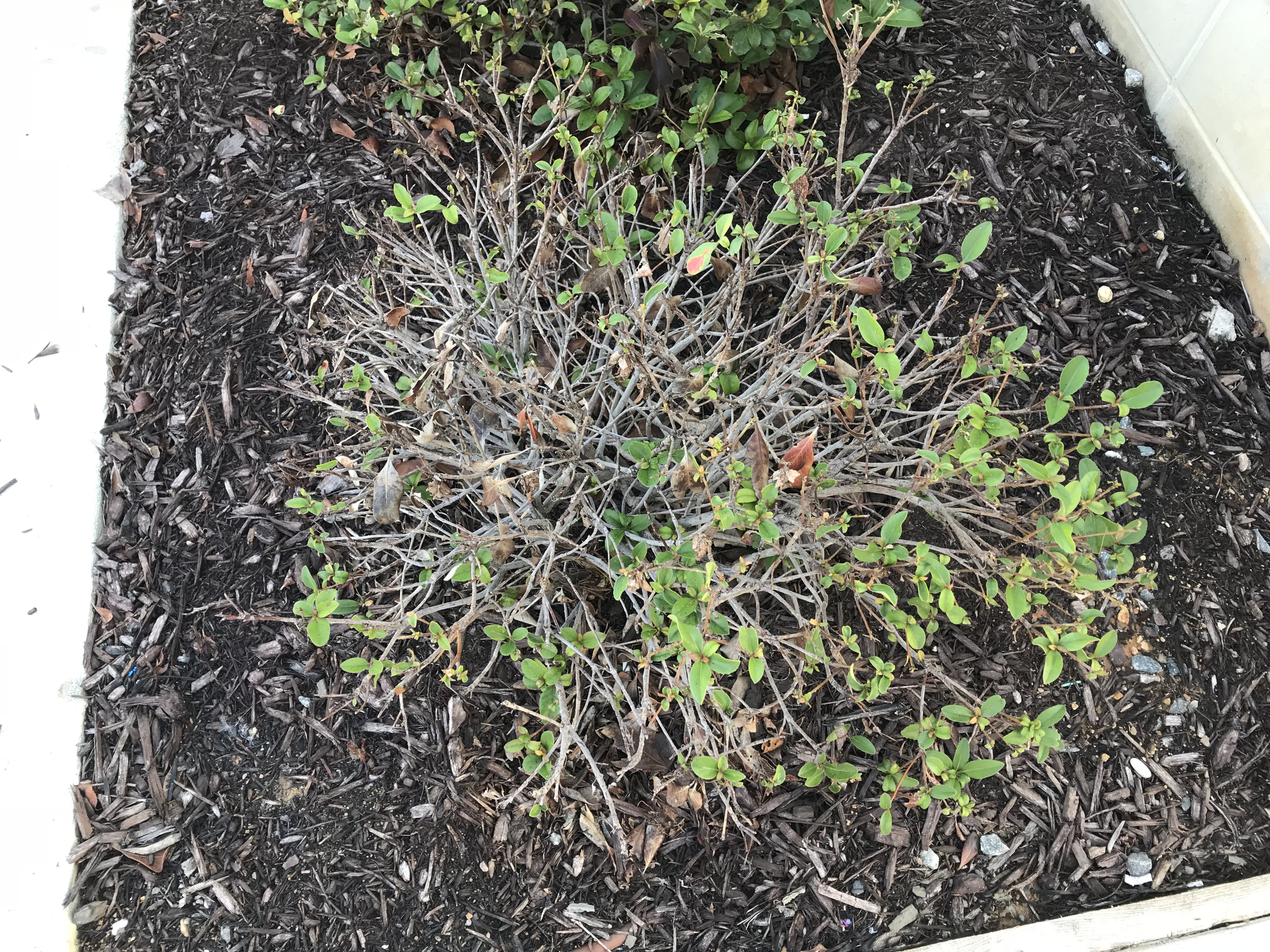
28 Jan 2019 Do Plants Need a Winter Coat?
Brrrr…. It’s cold outside. Though frigid this time of year, in the landscape industry we have to think about cold weather conditions even in the summertime. Richmond’s climate is a challenge at best, especially the past few years when we have seen winter temperatures plunge to near zero and/or below and summertime temperature exceeding 100 degrees Fahrenheit (with heat index even higher). We have also seen fluctuations in rainfall from a few drops over the course of months to several storms dropping 6”-10” of rainfall locally in just several days. Many people don’t realize that this area, often referred to as the transition zone, is one of the most temperamental areas in the country to grow plants.
A prominent issue that has become apparent in the past few years is the cold hardiness (or resistance to cold weather) of several plants that have been used in this region for quite some time. Some of the plants struggling in this climate include Crape Myrtles (red and pink varieties), Carissa Hollys and Indian Hawthorne, which were always thought to be able to survive in this part of Virginia. The United States Department of Agriculture (USDA) creates a map of plant hardiness in the United States and categorizes areas into “zones” based on historical climate and weather conditions for that region. 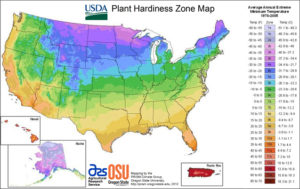 Currently the most recent map available to the public is from 2012. Based on the 2012 USDA Hardiness Map, the Richmond vicinity is bisected into Zones 7a (western Chesterfield, Henrico and Hanover Counties) and 7b (eastern Chesterfield, Henrico and Hanover Counties.) Zone 7a has a cold hardiness range between 0 to 5° F and 7b with a range of 5°to 10°F. We typically recommend using plants that are within 1 – 2 hardiness zones from where you are located. The ability of plants to adapt to certain climates is limited by their native region of origin. For example: the plant selection for the Richmond area zone 7a should be from areas no `colder’ than zone 8a. Plantings that typically thrive in Tidewater (Norfolk or Va. Beach), which is Zone 8a, may not survive in western Henrico County since it gets too cold in the winter. The Henrico area had several days in both 2017 and in 2016 that were at zero or below, which can cause serious damage and even death to certain plants.
Currently the most recent map available to the public is from 2012. Based on the 2012 USDA Hardiness Map, the Richmond vicinity is bisected into Zones 7a (western Chesterfield, Henrico and Hanover Counties) and 7b (eastern Chesterfield, Henrico and Hanover Counties.) Zone 7a has a cold hardiness range between 0 to 5° F and 7b with a range of 5°to 10°F. We typically recommend using plants that are within 1 – 2 hardiness zones from where you are located. The ability of plants to adapt to certain climates is limited by their native region of origin. For example: the plant selection for the Richmond area zone 7a should be from areas no `colder’ than zone 8a. Plantings that typically thrive in Tidewater (Norfolk or Va. Beach), which is Zone 8a, may not survive in western Henrico County since it gets too cold in the winter. The Henrico area had several days in both 2017 and in 2016 that were at zero or below, which can cause serious damage and even death to certain plants.
The following are some examples of common plants that have been used in the Greater Richmond area for many years with minimal negative effects from winter weather in the past but have recently suffered extensive damage and/or decline over the past two winters.
| Botanical Name: | Common Name: | Varieties: | Damage (Signs) |
| Trees: | |||
| Lagerstroemia sp. | Crape Myrtle | Red and/or pink varieties | Frozen Branches and outer stems |
| Acer palmatum | Japanese Maple | Cut-leaf/Lace-leaf varieties | Frozen leaves, outer stems/branches |
| Shrubs: | |||
| Camellia japonica | Japanese Camellia | Frozen leaves, flowers, outer stems | |
| Ilex cornuta `Carissa’ | Carissa Holly | Named cultivar | Frozen leaves, outer stems/branches |
| Ligustum japonicum | Wax-Leaf Ligustrum | All varieties | Frozen leaves, outer stems/branches |
| Myrica cerifera | Southern Wax Myrtle | All varieties | Frozen leaves, outer stems/branches |
| Raphiolepsis indica | Indian Hawthorne | All varieties | Frozen leaves, outer stems/branches |
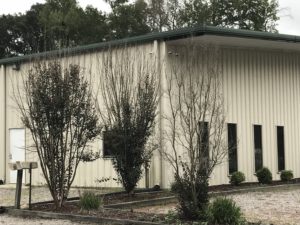
Winter Damage to Crape Myrtle (Lagerstromia sp.)

Winter damage to Crape Myrtle (Lagerstromia sp.)
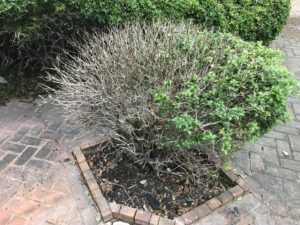
Winter damage to Chinese Holly (Ilex cornuta)
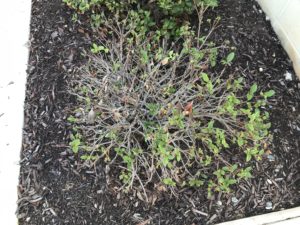
Winter damage to Indian Hawthorne (Raphiolepsis)
Not all plants from these groups suffered during the past winters, however, the plants that suffered the most damage and/or death of vegetative growth above ground were plants that were out in the open and directly exposed to the wind chill (which can lower the actual temperature drastically). Strategic placement of plants can provide protection for plants similar in a manner to wearing a winter coat. Without protection from other plants or structures from harsh weather conditions, such as wind and rain, these plants have a harder chance of survival.
All hope is not lost. Luckily we have not had prolonged sub-zero temperatures for longer than a couple of days. If we had experienced these extreme cold temperatures for a week or longer, many of these varieties, as well as many other plants would have extensive damage and/or death of all vegetative growth above ground level and possible below ground as well. Most of these varieties have the inherent ability to spring back new growth fairly quickly. With the proper pruning out of the dead growth and correctly timed fertilization, many of these plants can fill back in within a couple of seasons. These plants may look like Charlie Brown’s Christmas trees for some time after the damage is done by the cold, but in time they can return to healthy thriving plants with the proper care.
At KBJW, we use all resources available to the public by the USDA and other agricultural services to ensure the best plants are chosen for a project site. It is not enough to rely on maps to determine plant hardiness – experience becomes an invaluable resource to ensure the best plant selection and proper location for our ever fluctuating climate. For more information on plant hardiness and proper plant selection, please contact Gary Scottow, LA, at 804-200-1913 or via email at gscottow@kbjwgroup.com

